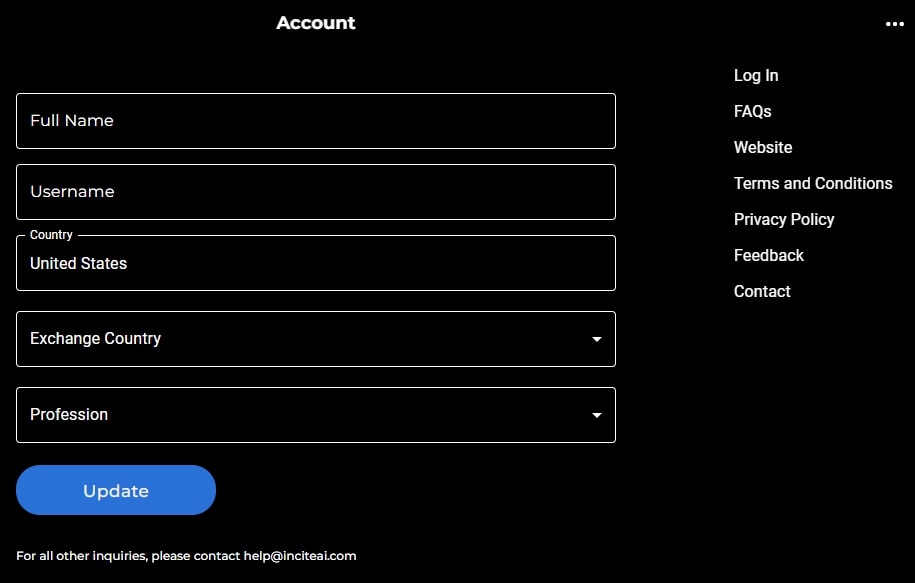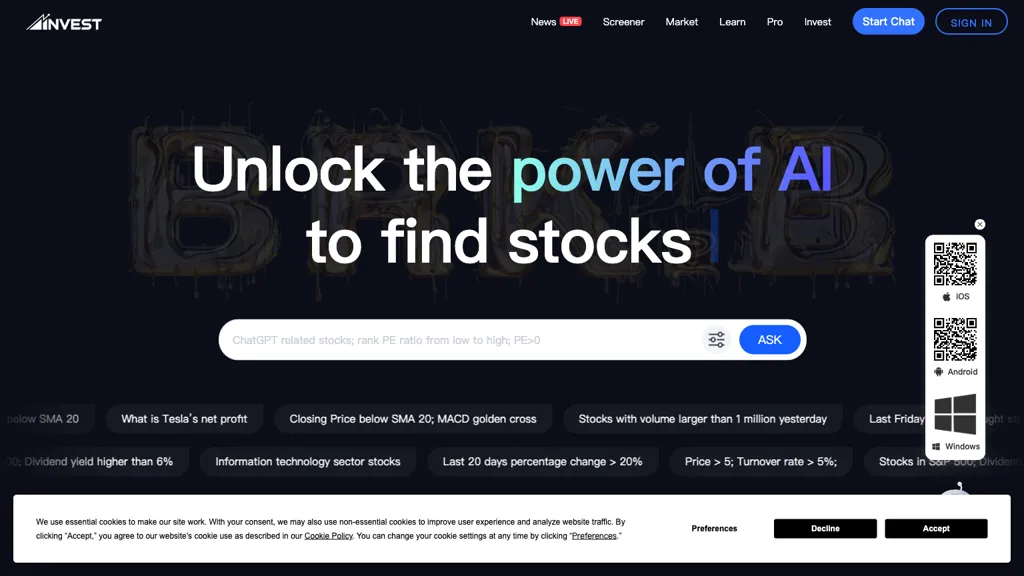Market coverage plays an important role in evaluating AI platforms for analyzing and predicting stocks which will determine your ability to access a vast array of financial markets. Market coverage is essential because it allows you to diversify, explore the world's markets, and adjust different trading strategies. Here are 10 tips on how you can evaluate the market coverage of platforms.
1. Evaluate Supported Asset Classes
Stocks - Ensure that the platform you choose to use can include the major markets for stocks (e.g. NYSE NASDAQ LSE HKEX) as well as includes mid-caps, small-caps, and large-caps.
ETFs - Check to see whether your platform can support the wide range of ETFs which offer exposure in many diverse regions, sectors or themes.
Futures and options. Make sure that the platform is compatible with derivatives such futures contracts, options, and leveraged instruments.
The commodities and forex. Find out whether there are any forex pairings available, as well as precious metals, commodities for energy, and agricultural commodities.
Cryptocurrencies. Check if it supports the major altcoins and cryptocurrencies (e.g. Bitcoin, Ethereum).
2. Check coverage of your area
Global markets: Make sure the platform is able to cover major global markets, which include North America, Europe, Asia-Pacific, and emerging markets.
Regional focus: Find out whether the platform is focusing on particular market segments or regions that are in line with your preferences for trading.
Local exchanges: Check whether the platform is compatible with regional or local exchanges that relate to your location or strategy.
3. Assessment Real-time as opposed to. delayed data
Real-time Data: Be sure that the platform has real-time information for trading, and to make timely decisions.
The data is delayed. Check if the delayed data is available at no cost or at a lower cost, which may suffice for long-term investors.
Data latency - Make sure that the platform minimizes the delay of feeds that are real-time. This is crucial for traders with high frequency.
4. Analyze historical data availability
Historical depth: Make sure that the platform can provide ample historical data (e.g. over 10 years worth of data) to analyze and backtest.
Check the granularity of data from the past.
Corporate actions: Verify that the data from the past takes into account stock splits (if appropriate), dividends, and any other corporate action.
5. Review market depths and make an order for books
Level 2 data: Check that the platform has Level 2 data for price discovery and for better execution.
Bid-ask Spreads: Make sure that the platform is showing real-time spreads for bid and ask for accurate pricing.
Volume data: Ensure that the platform is equipped with detailed information on volume to analyze market activity and liquidity.
6. Review the coverage of Indices and Sectors
Major indices - Ensure your platform is compatible with major indices, such as the S&P 500 (e.g. NASDAQ 100 or FTSE 100), for benchmarking using indexes.
Information for specific industries: If you want to conduct a more specific analysis, see if there is data available for specific sectors.
Customized indexes. Find out if the platform allows you to create and track custom indexes based on the criteria that you set.
7. Evaluation of integration with News and Sentiment data
News feeds : Ensure you have a platform that integrates live news feeds, preferably from reliable media sources (e.g. Bloomberg and Reuters) to cover the most significant market events.
Sentiment analysis: Find out whether the platform offers sentiment analysis tools based on news, social media or other sources of data.
Strategies that are based on events (e.g. economic announcements, earnings announcements): Check if your platform allows trading strategies based on events.
8. Make sure you are aware of the Multimarket Trading Capabilities.
Cross-market trading: Make sure the platform allows trading across multiple assets, markets, and exchanges through an interface that is single.
Currency conversion: Check if the platform is compatible with multicurrency accounts as well as currency conversions for international trading.
Time zone support: Determine whether the trading platform can be used in different time zones for markets across the globe.
9. Examine the coverage of alternative data Sources
Alternative data: To get new insights, make sure that the platform incorporates different sources of data.
ESG Data: Check to see whether there are any data on the environment, social or governance (ESG data) that are part of the platform for socially responsible investing.
Macroeconomic Data: Ensure whether the platform contains macroeconomic indicators, such as inflation, GDP and interest rates.
Review Market Reputation and User Reviews
User reviews: Review user feedback in order to assess the platform's market coverage, reliability, and usability.
Check the reputation of the platform, in terms of its coverage or industry awards.
Case studies and testimonials They will showcase the platform's performance in specific asset classes or markets.
Bonus Tips
Trial period: Test the platform for free to test how it covers market trends and the types of data available.
API access: Ensure that the API of the platform permits you to programmatically access market data for custom analysis.
Customer support: Ensure the platform offers support for market-related queries or issues with data.
By using these tips using these tips, you will be able to be able to accurately evaluate the coverage of AI software for stock prediction and analyzing trading platforms. You can then choose a trading platform that offers you the markets and the necessary information to be successful in your trades. Comprehensive market coverage will allow you to diversify, explore, and adapt your portfolio in response to market conditions. Check out the top stock ai recommendations for website recommendations including ai trade, trading with ai, ai for stock trading, ai for investing, best AI stock, AI stock picker, chatgpt copyright, trading with ai, AI stocks, best ai for trading and more.

Top 10 Suggestions For Evaluating The Scalability Ai Trading Platforms
Assessing the scalability of AI-driven stock prediction and trading platforms is essential to ensure they can handle increasing data volumes, user demands and market complexities. Here are the top 10 ways to assess the scaleability.
1. Evaluate Data Handling Capacity
Tips: Make sure that the platform is able to process and analyse large data sets.
Why: Scalable platforms need to handle increasing data volumes without performance degradation.
2. Test Real-Time Processing Capabilities
See how the platform handles live streams of data, including news and stock prices.
Reason: Delays in trading decisions can lead to missed opportunities.
3. Cloud Infrastructure Elasticity and Check
TIP: Check whether the platform is cloud-based infrastructure (e.g., AWS, Google Cloud, Azure) and has the ability to scale resources in a dynamic manner.
Why cloud platforms are so popular: They provide flexibility, allowing systems to scale up or down depending on the demand.
4. Algorithm Efficiency
Tips: Find out the effectiveness of AI models that are used to make predictions (e.g. Deep Learning and Reinforcement Learning).
Why: Complex algorithms require a lot of resources. Thus optimizing them can help you scale.
5. Study parallel processing and distributed computing
Tip: Verify if the platform uses parallel processing frameworks or distributed computing frameworks.
What is the reason? They can speed up data processing across many nodes.
6. Review API Integration and Interoperability
Tip Check the platform's capability to connect with APIs from outside (e.g., brokerage APIs, market data providers APIs).
Why? Seamless integration allows the platform to be adapted to new trading environments as well as data sources.
7. Analyze User Load Handling
Try simulating high traffic levels to test how your platform will perform.
Why: A scalable platform will provide performance even as the number of users grows.
8. Assessment of Model Retraining and Adaptability
Tip: Check how often the AI model is retrained and with what degree of efficiency.
Why? Models have to constantly adapt to the changing market to ensure that they remain precise.
9. Check for Fault-Tolerance and Redundancy
Tips: Make sure the platform has failover mechanism and redundancy to handle hardware or software failures.
Why: Trading can be expensive So the ability to handle faults and scale are crucial.
10. Monitor Cost Efficiency
Tips: Calculate the cost of expanding your platform. Consider cloud resources, data storage, and computational power.
The reason is that it should be at a cost that is viable. This means balancing performance against expense.
Bonus tip: Future-proofing
ensuring that the platform will be able to handle the latest technologies (e.g. advanced NLP quantum computing, quantum computing) as well as regulatory changes.
It is possible to assess the capacity and effectiveness of AI trading and stock prediction systems by looking at this aspect. This will help ensure that they're effective and robust, prepared for growth. Follow the best AI stock price prediction for site recommendations including free AI stock picker, ai copyright signals, trading ai tool, best ai for stock trading, ai in stock market, AI stock trader, ai software stocks, trading ai tool, can ai predict stock market, AI stock trader and more.
